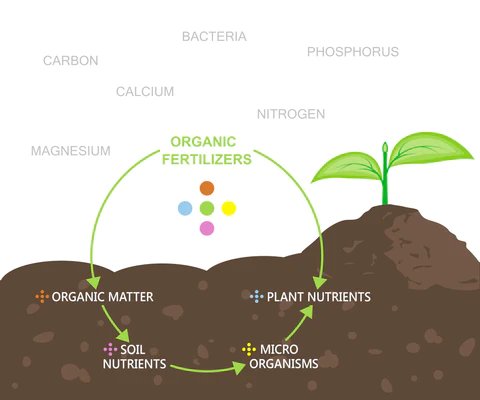Nutrient Management
Nutrient management involves the efficient use of fertilizers and soil amendments to optimize crop production while minimizing environmental impacts. This approach is crucial for reducing greenhouse gas emissions, improving water quality, and enhancing soil health.

Soil nutrient management (Earth Smart Solutions)
View open jobs in this Solution
Example Companies / Organizations
- Regrow - Software platform for agronomy and scenario planning with monitoring, reporting, and verification to improve nutrient management.
- The Climate Corporation - Provides digital tools for precision agriculture.
- Yara International - Develops fertilizers and crop nutrition solutions.
- The Fertilizer Institute - Advocates for the responsible use of fertilizers.
Overview
Nutrient management involves the efficient use of fertilizers and soil amendments to optimize crop production while minimizing environmental impacts. Significant progress has been made in developing technologies and practices that enhance nutrient use efficiency and reduce emissions.
Progress Made
Significant advancements have been made in nutrient management strategies:
- Precision Agriculture: Utilizes GPS, sensors, and data analytics to optimize fertilizer application.
- Enhanced Efficiency Fertilizers: Slow-release and stabilized fertilizers improve nutrient uptake and reduce losses.
- Soil Health Practices: Cover cropping, reduced tillage, and organic amendments enhance soil fertility and structure.
Solutions by Sector
Precision Agriculture
- Variable Rate Technology (VRT): Adjusts fertilizer application rates based on soil and crop needs.
- Remote Sensing: Uses satellites and drones to monitor crop health and nutrient status.
- Soil Testing and Mapping: Provides detailed information on soil nutrient levels and variability.
Case Studies:
- The Climate Corporation, USA: Offers digital tools for precision agriculture, improving nutrient use efficiency (The Climate Corporation).
- Yara International, Norway: Develops precision farming solutions to optimize fertilizer use (Yara International).
- John Deere Operations Center, USA: Provides a platform for managing precision agriculture data (John Deere).
Enhanced Efficiency Fertilizers
- Slow-Release Fertilizers: Release nutrients gradually to match crop uptake.
- Stabilized Fertilizers: Contain additives that reduce nutrient losses to the environment.
- Organic Amendments: Use compost, manure, and other organic materials to improve soil fertility.
Case Studies:
- Nutrien, Canada: Produces enhanced efficiency fertilizers to improve nutrient use efficiency (Nutrien).
- ICL Group, Israel: Develops controlled-release fertilizers for various crops (ICL Group).
- AgroLiquid, USA: Offers liquid fertilizers with enhanced efficiency properties (AgroLiquid).
Soil Health and Conservation
- Cover Cropping: Planting cover crops to improve soil health and reduce erosion.
- Reduced Tillage: Minimizing soil disturbance to maintain soil structure and organic matter.
- Nutrient Recycling: Using crop residues and animal manures to recycle nutrients.
Case Studies:
- General Mills, USA: Implements regenerative agriculture practices, including cover cropping and reduced tillage (General Mills).
- Rodale Institute, USA: Conducts research on organic farming and soil health practices (Rodale Institute).
- The Nature Conservancy, USA: Promotes soil health practices through partnerships with farmers (The Nature Conservancy).
Lessons Learned
- Nutrient Management as a Tool: Effective nutrient management can significantly reduce greenhouse gas emissions and improve water quality.
- Tailored Approaches: Different regions and crops require specific nutrient management strategies.
- Environmental Considerations: Pre-implementation assessments are crucial to avoid negative environmental impacts.
- Guidance and Support: Multiple organizations provide valuable guidance and support for nutrient management practices.
Challenges Ahead
- Awareness Deficit: Many farmers and policymakers are unaware of the benefits and potential of nutrient management.
- Insufficient R&D Investment: More funding is needed for research and development to improve practices and technologies.
- Scalability Issues: Scaling up nutrient management practices to have a broad impact remains challenging.
- Farmer Adoption: Farmers need awareness, training, and support to implement nutrient management practices effectively.
Best Path Forward
- Public Awareness: Increase awareness of nutrient management benefits among farmers, policymakers, and the public.
- Financial Incentives: Provide financial incentives to encourage farmers to adopt nutrient management practices.
- Research and Development: Invest in R&D to develop better nutrient management practices and technologies.
- Policy Support: Collaborate with governments and global entities to create supportive policies for nutrient management.
- Demonstration Projects: Establish demonstration projects to showcase the potential of nutrient management.
Prominent supporters include the World Bank, UN Food and Agriculture Organization, and International Fertilizer Industry Association.
Image credit: Earth Smart Solutions